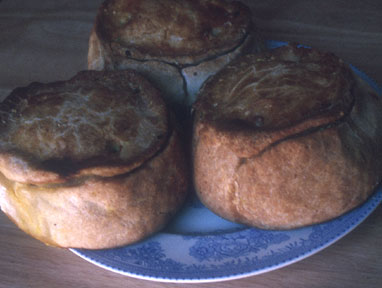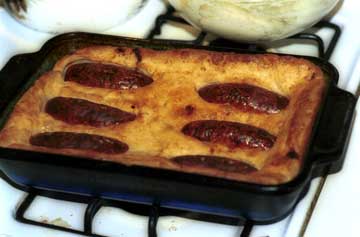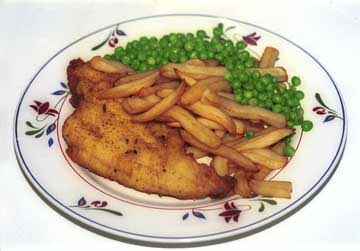Still Cooking.... 
Pork Pies
Fresh out of the oven.
There are many recipes for pork pies, I'd guess as many as there are people that make them. Traditionally they take a long time preparing the ingredients, making the stock by boiling down bones with a selection of vegetables and herbs. Dicing the meat instead of grinding it. A lot of choices make little difference to the final product but save a lot of time.
The Pork Pie is one of those traditional English foods like Fish & Chips or the Cornish Pasty that you cannot find anywhere. If you do find something that is supposed to be the traditional English fare then you'll most likely be very disappointed but that's a whole different story. I personally like a little brown sauce (HP or Daddies) or pickled onions with my pie. Like many of the excellent traditional English foods the Pork Pie goes down well with half a pint of Best Bitter or IPA.
English Pork Pie Recipe
For a 1 lb Pie
Filling: 1 LB pork with fat about quarter to half teaspoon of salt. Black pepper freshly ground. 1 teaspoon of mixed herbs or sage and thyme. Jelly: quarter pint of pork stock or chicken stock gelatine (check with the packet one sachet normally makes a pint add a little more than dividing it down would suggest). Hot Water Crust: 1 LB plain flour 1 teaspoon of salt 1 egg 7 oz lard Half pint of water. A little milk for glazing.
Prepare the filling first, mix the herbs, salt and black pepper thoroughly and set aside. Put the flour into a large mixing bowl, make a well in the centre. Put the lard into a saucepan, add the water and bring to the boil. When the lard has melted, pour the contents into the well in the flour. Quickly stir with a wooden spoon until a dough is formed, beat an egg and mix in thoroughly.
When the dough can be handled tip out of the bowl onto a pastry board, cut off about a quarter for the pie lid. Pat out the rest into a disk take a suitable jar (one with parallel sides and sufficient diameter 3-4 inches) and mould the dough up the jar. Leave it to cool and then ease the pastry off the jar, this is not so easy as it can crack. The pastry should be about a quarter of an inch thick and the depth of the pie about three to four inches. They used to use wooden formers with a very slight taper.
Put the meat into the pie, role out the remaining quarter to make a lid make a hole in it about a quarter of an inch (6mm) so that the jelly can be poured in when the pie is cooked. Put the lid on the pie and seal it brush the top with milk to glaze it and put it in the pre heated and bake at 350F for one to one and a half hours. The pie should be golden brown when done.
While the pie is cooking heat the stock and mix the gelatine.
Remove the pie from the oven allow to cool and pour the stock mix into the pie through the hole. Leave the pie for about a day for the stock to set into a firm jelly.
This is how I made the pies in the picture above. I read many recipes and adapted this one to what I had and what I remembered of how a good pork pie should be. When the pies are baking they belly out a little, this is the way that I remember the best of the pies, not those mass produced ones with straight sides.
I know it seems a lot of fuss but it was really worth it.
Toad in the Hole
A traditional British dish, tasty beyond compare and simple to prepare. This is great for a quick (about half an hour) dinner any time between autumn and spring. Mashed potato and peas or green beans accompany this very well.
Ingredients
Serving of 2 to 3
6 Good quality pork sausages about 1lb. These may be difficult to find in the USA so maybe good breakfast Sausages will do. A table spoon or so of cooking oil, if the sausages do not produce fat. The batter 3oz of plain flour, though I've used anything I had when I had to substitute without much difference. 1 egg 5 oz of milk Salt and pepper to taste, in other words what ever you like. Onion gravy (which goes very well with this). Half a pound of onion peeled halved and sliced or chopped large'ish. 1 pint of water. about three table spoons of cooking oil. one tea spoon of granulated or caster sugar. one stock cube pork or beef will do. about one or two table spoons of plain flour for thickening, depends how you like your gravy. You will also need an oven proof baking tin about 9 x 6 x 2 inch, one of those enameled cast iron types would be best but I use an 8 x 6 stainless steel tin. A frying pan for the onions, that will take a pint or more.
Process:
Pre-heat the oven to 450.
Mix the batter and set it aside.
Cut-up the onions put the them and the oil in the frying pan, start cooking
them.
Arrange the sausages in the baking tin and put them in the oven when the oven is ready.
When the onions are starting to brown sprinkle the sugar on them to caramelize (brown).
After the sausages have been in the oven for about ten minutes check them to see if they are starting to brown. If they are browning take the tin out and pour in the batter and return the tin to the oven quickly, not forgetting to stir the batter before pouring.
By now the onions should have started to brown, take some of the water for the gravy and mix with the flour put the rest in the frying pan and continue heating. Crumble the stock cube into the frying pan and stir. As you are stirring pour in the flour mix. Keep stirring until the gravy thickens.
About ten to fifteen minutes from putting the baking tin back in the oven check to see if the batter has raised and is going brown. When it has raised to either the top of the sausages or the tin and is golden brown then it is ready to serve.
The Perfect chip
Chips can be made with any variety of potato some are said to be better than others but as not all varieties are available all over the world we'll skip that part.
I've found that potatoes from the later harvests are better, the large ones. They also improve a little for keeping too, although many people think when the potato is beginning to go soft it's no good and indeed that may be the case for other uses of it but not for chips.
The potato should be pealed and cut into strips around 8mm or 3/8th inch thick and as long as the potato or shorter if you wish. Traditionally beef dripping was used for the best frying fat, this however is both scarce these days and not to some peoples liking. Any high temperature oil or fat will do preferably one which will add little taste of it's own. The last secret to the perfect chip is that they should be cooked twice. The fat should be at about 350F before the chips are fried the first time. The chips should be fried until they have turned pale yellow and are not quite cooked all the way through, this can be tested by extracting one and pinching it between finger and thumb, it should have a little give but not be soft. This test is also quite painful at times but real chef's loose feeling in their fingers after years of cooking.
When they are ready remove them to a warm place and allow the fat to heat up to 350F again then plunge the chips into the fat/oil and cook until they both float and turn a golden brown. You could test them again, this time the outer should be firmer but give to increased pressure and the interior be softer. I don't normally do this as I like to keep the feeling in my finger tips.
As soon as the chips are ready remove them from the fat drain as much fat/oil off them as you can and serve.
Depending what the chips will be served with, you may wish to use salt and
malt vinegar or brown sauce like HP of Daddies or maybe tomato ketchup.
See Chip Butty for other ways to serve chips.
Fish & Chips.
At one time fish and chips not "fish'n'chips" were the Britain's main take away food and a very good dinner too. You could have an 8 penny fish and 4 pence of chips, of had a jolly good meal and only spent a shilling.
The chips I have described elsewhere so it's only the fish we'll talk of here.
I have used lots of different batters and this one is the simplest and works
for me. It is however very important to get the right consistency so that
it coats the fish without running off.
It is also extremely important to use very hot oil, it should be at around 400F or just where it starts to smoke a little but be careful not to over heat it as this will be it's maximum temperature. Traditionally the fat used for frying was beef dripping fat saved from the roast and it really does make the chips taste a lot better. These days most fish and chip shops in England use that solid oil. I have use lard and a variety of oils some of which tend to break down at high temperatures and soon don't taste as good.
Make the chips first and put them in an oven proof dish in the oven on warm.
Fish:
Either Cod or Haddock for preference but many kinds of white fish are used.
I like an 8oz thick fillet but 6oz pieces are OK.
The batter:
This is for one fish if you are making more adjust accordingly. The following
measurements are approximate as I tend not to actually use measures.
1 cup of flour
1 tablespoon of corn starch
1 teaspoon baking powder
milk as required
salt and pepper for seasoning
Mix the dry ingredients in a dish large enough to draw the fish through the mixture, dredge the fish in the dry mix and set aside, When the oil is at temperature, add milk and mix until it has the consistency of a thick pouring cream, if you lift the dish it should move slowly but not be a paste. Take the fish and lower it into the batter holding it at one end, usually the tail, lifting it out and do the same for the other side. If you are making a large number of fish you may have enough batter to coat both sides at once. Hold the fish by the tail for a few moments for any excess batter to drip off then plunge it into the hot oil
With this mixture I find it works best if the mixture is made as close to the oil getting to temperature, in other words don't let it stand or it may not rise so much on the fish.
Then place the fish in the hot oil and cook until it floats and the batter has turned a rich golden brown colour. I some times have to hold it down in the oil until the batter is golden brown all over. You've got the right mixture when, the fish is cooked and you can lift the batter off the fish on your plate. Of course by then there's nothing you can do except try a small adjustment next time.
When done set on a plate with the chips add salt and malt
vinegar to taste.
Bubble & Squeak
This is a traditional dish often eaten for breakfast. It was I guess invented as an ecological and economic way to use leftovers. However it is very tasty despite it's humble origins.
Essentially this is a potato dish which is cooked in a frying pan.
The ingredients may vary to some extent depending on what is left over.
Ingredients:
Mashed potato
any green vegetable preferably Brussels sprouts, cabbage or other leafy greens
or green beans or any greens. you may add other left over vegetable but the
larger proportion should always be potato as this is what binds it all together.
half ounce or so of fat or oil for the pan.
With a large bowl, first put the mashed potato spread it out then add the
green vegetables and mix thoroughly if possible breaking up the greens in
the process. If for any reason it is not binding you can add an egg but that
should not be required. Heat the frying pan, place a little fat or oil in
the pan to cover the bottom. Empty the mixture into the pan and cook until
the potato browned, if you like the taste of the browned potato turn it in
to the mix and brown again. Finally turn over the mix so the browned side
is on the top and brown what was the top.
Serve portions you can add salt, in England very often brown sauce is poured on top, Heinz Traditional steak sauce is a good substitute in the USA.
It really does taste better than it sounds.
Beans on Toast
This is a traditional British meal for breakfast, lunch or an anytime snack. At least since the end of the second world war. This essentially simple meal is despite it's use of butter a healthy meal. It's very quick to prepare and very welcome when you have very little time.
The following could feed two or if you are hungry it's not too much for one.
Ingredients:
Two slices of bread toasted
One 16oz can of baked beans
Enough butter to spread on the toast.
Black pepper, fresh ground.
It is best to use real butter, substitutes just don't have the right taste. The taste of this dish comes from the combination of it's Ingredients, any change seems to beak the spell. White bread usually makes the best toast. The toast may be allowed to cool before liberally spreading on the butter. Arrange the slices on a dinner plate, heat the beans and pour the beans over the buttered toast and sprinkle black pepper on top of the beans.
The beans in Britain would be Heinz beans made to a British recipe, I've not discovered anything in the USA that has quite the same taste, however Bush's Vegetarian beans seem to make a suitable substitute.